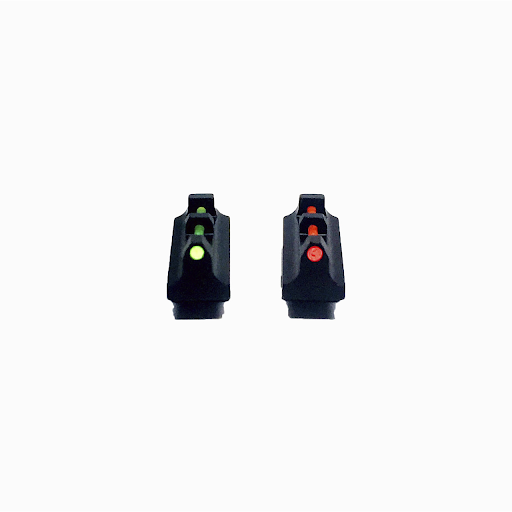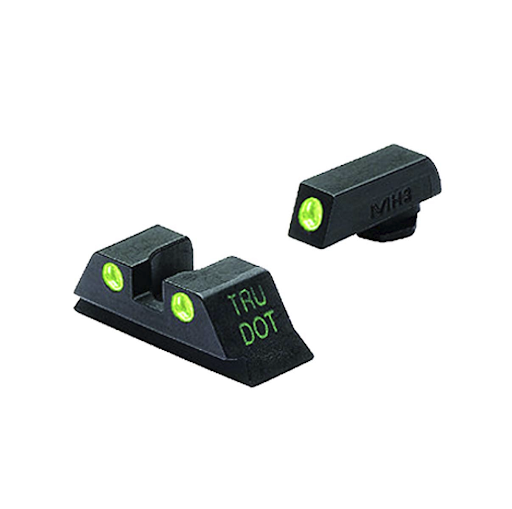Tritium Night vs. Fiber Optic Sights: Comparison Guide
Posted by Ranger Point Team on Sep 28th 2021
For a seasoned gun owner, their gun is not completely theirs until they know about every aspect of it inside out. Hence, they tend to spend a great deal of time researching and playing around with different gun parts and accessories to understand what matches their personal style. When it comes to firearm modifications, the most common and DIY-friendly one is the sights of the gun. Depending on the purpose and the gun type, you can choose between multiple sight types:
- Iron or Open Sights
- Peep sight
- Telescopic Sights
- Reflex sights
- Laser Sights
When shooting in dark or low-lit environments, people opt for reflex sights such as tritium sights or fiber optic sights. Both sights help the shooter gain a relatively accurate shot very quickly but each has its benefits. Yet, asking on the forums results in heated arguments with people choosing their camps for night sights vs fiber optic. In this article, we shall look into each and provide you with all the information about each.
What is Fiber Optic Sights? 
Fiber optic is a thin strand of plastic or glass that is thin as a human hair strand, and is different from a rifle peep sight. Owing to its unique construction, light is transmitted along its length. So, in the telecommunication industry fiber optics is used as a data transmission channel, while in firearms, it is used as low-light sight attachments for pistols and other handguns. It picks up ambient light and traps it along the length of the fiber and makes it easy to see. So in low-light and near-dark situations, a fiber optic sight is a superior aiming point when looking through the iron sights of a gun. In well-conditions as well, the sights work well without any adjustments needed.
When it comes to accuracy and rapid aiming, fiber optics is a better choice for longer ranges. In terms of durability, the outer sheathing provides sufficient protection, and most brands also provide spare fiber-optic tubes in case of damage. Fiber optic pistol sights are available in a wide range of colors but the most popular are orange, yellow, and green for easy visibility. Since the fiber only relies on the ambient light for visibility, it has a longer shelf life compared to the tritium sights, where the illumination is due to the chemical reaction.
Benefits Of Fiber Optic Sights
- Durable
- Lightweight
- Requires very less ambient light
- Better accuracy
- Rapid Aiming
- Better for longer range aims
- Useful even in bright sunlight
- Easy to replace fiber optic spares
Shortcomings Of Fiber Optic Sights
- Impractical in complete darkness
- Requires getting used to
- Not for everyone’s liking
What is Tritium Night Sights?

Tritium is a radioactive isotope of hydrogen and its gaseous form is used in tritium night sights. Since it produces low-intensity light, it doesn’t degrade your night vision or give away your location easily. So it is widely used in applications such as emergency exit signs, illumination of wristwatches, and gun sights. Illumination happens due to the luminosity property of the phosphor layer inside the tube filled with tritium gas. The electrons emitted by the tritium gas due to beta decay are absorbed by the phosphor layer and emitted as a faint glow. It requires no electrical energy and is capable of producing long-lasting light that is visible in dim-lit environments.
On the contrary, it is not effective in aiming at a brightly lit or daylight environment. Also, the tritium night sights are expensive compared to fiber optics. In terms of durability, the half-life of tritium is 12.5 years, the light becomes half of the original after 12.5 years. However, having your tritium sights last that long is an achievement in itself. Unlike most people say, the exposure to tritium, in case of breakage, poses no health hazard in itself. The extremely small amount of tritium would disperse in the air in a few minutes. If inhaled or ingested, drink lots of water and it would be flushed out within a couple of weeks.
Benefits of Tritium Night sights
- Durable
- Lightweight
- Works in complete darkness
- No need for an external power source
- Better accuracy
Shortcomings of Tritium Night sights
- Ineffective in broad daylight
- Expensive
- Not possible to turn it ‘off’
- Risk of exposure if the sights break (even though not potent)
- Light Intensity reduces over time
Wrapping Up
Fiber optic rifle sights are multipurpose while tritium ‘outshines’ in completely dark environments. Moreover, fiber optic is more suitable for rifles owing to the superiority in long-range shooting. However, do your research and browse Ranger Point Precision’s wide range of sight types to understand the performance of different sight types before making the plunge.
Frequently Asked Questions
How do I know what size peep sight to get?
Some shooters prefer a smaller peep sight aperture for low light situations, while others prefer a larger peep sight that provides for more adjustment in full daylight. Ultimately, it's up to you to experiment with different sizes to find what works best for you.
What degree is a peep sight?
The degree of a peep sight is simply how far away it can be adjusted to line up the barrel with the target. Most peep sights have a range between 100 and 200 yards, but some can be adjusted for even longer distances.
What’s better for hunting - tritium or fiber optic front sights?
Tritium looks super cool because it glows in the dark but is it practical in a front rifle sight for hunting? In our opinion, the “cool factor” is all that it’s got. During the day, tritium does not glow at all unlike a fiber optic which glows a lot. At night let’s say you’re pig hunting, it’s not as useful as using a flashlight and a red dot; or a flashlight and scope and night vision; or a red dot and night vision.
Checkout: better sights henry 22

